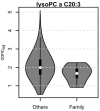Genetic and Metabolic Determinants of Atrial Fibrillation in a General Population Sample: The CHRIS Study
- PMID: 34827661
- PMCID: PMC8615508
- DOI: 10.3390/biom11111663
Genetic and Metabolic Determinants of Atrial Fibrillation in a General Population Sample: The CHRIS Study
Abstract
Atrial fibrillation (AF) is a supraventricular arrhythmia deriving from uncoordinated electrical activation with considerable associated morbidity and mortality. To expand the limited understanding of AF biological mechanisms, we performed two screenings, investigating the genetic and metabolic determinants of AF in the Cooperative Health Research in South Tyrol study. We found 110 AF cases out of 10,509 general population individuals. A genome-wide association scan (GWAS) identified two novel loci (p-value < 5 × 10-8) around SNPs rs745582874, next to gene PBX1, and rs768476991, within gene PCCA, with genotype calling confirmed by Sanger sequencing. Risk alleles at both SNPs were enriched in a family detected through familial aggregation analysis of the phenotype, and both rare alleles co-segregated with AF. The metabolic screening of 175 metabolites, in a subset of individuals, revealed a 41% lower concentration of lysophosphatidylcholine lysoPC a C20:3 in AF cases compared to controls (p-adj = 0.005). The genetic findings, combined with previous evidence, indicate that the two identified GWAS loci may be considered novel genetic rare determinants for AF. Considering additionally the association of lysoPC a C20:3 with AF by metabolic screening, our results demonstrate the valuable contribution of the combined genomic and metabolomic approach in studying AF in large-scale population studies.
Keywords: Cooperative Health Research in South Tyrol; GWAS; atrial fibrillation; familial aggregation; metabolomics; rare alleles.
Conflict of interest statement
The authors declare no conflict of interest.
Figures





References
-
- Kirchhof P., Benussi S., Kotecha D., Ahlsson A., Atar D., Casadei B., Castellá M., Diener H.C., Heidbuchel H., Hendriks J., et al. 2016 ESC Guidelines for the management of atrial fibrillation developed in collaboration with EACTS. Eur. Heart J. 2016;37:2893–2962. doi: 10.1093/eurheartj/ehw210. - DOI - PubMed
-
- Hindricks G., Potpara T., Dagres N., Arbelo E., Bax J.J., Blomström-Lundqvist C., Boriani G., Castella M., Dan G.A., Dilaveris P.E., et al. 2020 ESC Guidelines for the diagnosis and management of atrial fibrillation developed in collaboration with the European Association of Cardio-Thoracic Surgery (EACTS) Eur. Heart J. 2021;42:373–498. doi: 10.1093/eurheartj/ehaa612. - DOI - PubMed
MeSH terms
Substances
LinkOut - more resources
Full Text Sources
Medical

